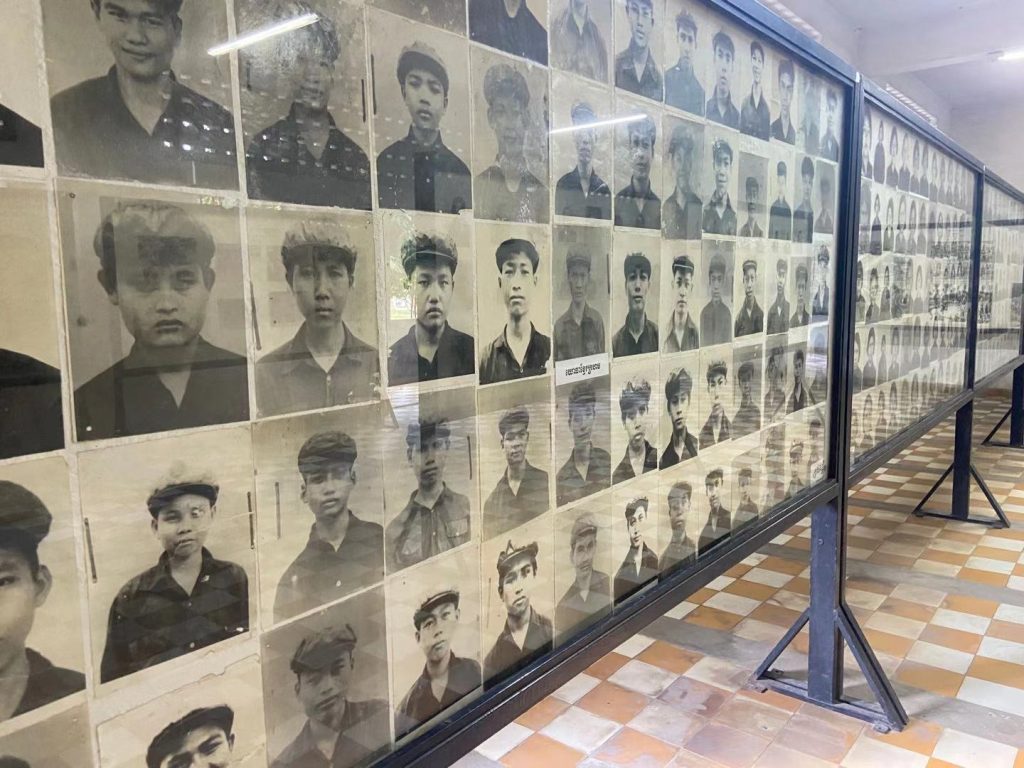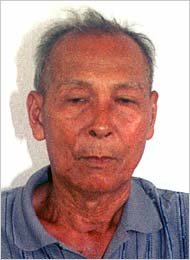What was S-21, AKA Tuol Sleng? Now known as the Tuol Sleng Genocide Museum this was the largest and most politicized prison camp ran by the Khmer Rouge during the time of Democratic Kampuchea.
It was located in central Phnom Penh and was where anyone suspected of political crimes was interrogated, usually forced to “confess” and then killed. Once the site was overfilled the Choeung Ek Killing Fields were used to deal with the excess, as well others that were being executed.
Why was S-21 formed?
S-21 was formed as prison camp in around March of 1976, just two months after the official formation of Democratic Kampuchea and as the Khmer Rouge were starting to speed up the “revolution”.
The site used was Tuol Svay Prey High School, which was converted into the prison it is known as today. Its central location was due to the fact that it was close enough to the party centre, but with the city now evacuated still far away from prying eyes.
Its specific formation was to deal with those deemed political prisoners real, or not. This was also part of the Super Great Leap Forward, whereby enemies of the state would be eliminated quickly in order to achieve success in the revolution.


S-21 Death Camp
Initially a death camp with people buried outside in later years people were often shipped to the Killing Fields to be killed, where there was more space to bury bodies.
Generally speaking prisoners would come to the prison and be tortured until they confessed, although even that had to be done “correctly”. Some people did this quickly, while others lasted much longer.
All of these confessions were meticulously recorded and indeed reported to the higher brothers of Angkar. It is esteemed that around 20,000 people went through S-21, with there being around 12 known survivors.
Rules for prisoners;
- You must answer accordingly to my question. Don’t turn them away.
- Don’t try to hide the facts by making pretexts this and that, you are strictly prohibited to contest me.
- Don’t be a fool for you are a chap who dare to thwart the revolution.
- You must immediately answer my questions without wasting time to reflect.
- Don’t tell me either about your immoralities or the essence of the revolution.
- While getting lashes or electrification you must not cry at all.
- Do nothing, sit still and wait for my orders. If there is no order, keep quiet. When I ask you to do something, you must do it right away without protesting.
- Don’t make pretext about Kampuchea Krom in order to hide your secret or traitor.
- If you don’t follow all the above rules, you shall get many lashes of electric wire.
- If you disobey any point of my regulations you shall get either ten lashes or five shocks of electric discharge.


Staff of S-21
Around 1800 people are known to have worked at S-21, with many of the tortuous guards being children taken from imprisoned families.
The biggest unit at S-21 was the defense unit who were mostly teenagers and faced some of the strictest rules within the prison, such as no fraternisation with prisoners, no naps as well as not eavesdropping on interrogations, something almost impossible to avoid. This made them particularly fearful of the regime, particular as many guards would also end up as prisoners.
The interrogation unit was split into three separate groups: Krom Noyobai or the political unit, Krom Kdao or the hot unit and Krom Angkiem, or the chewing unit. Different units were gibe different rules and privileges, such as the ability to be able to torture prisoners.
At the top of the prison was Comrade Duch a former math teacher who was particularly close with Communist Party of Kampuchea leader Pol Pot. As well as being the head of S-21 Duck also held a senior position in Santebal the secret police of Democratic Kampuchea.
Other key leaders at the prison include the ruthless head of the interrogation unit Mam Nai. Mam defected from the Khmer Rouge just before Pol Pot ordered the exception of Son Senn during the time of the Cambodian National Unity Party.
Famous prisoners of S-21
Even though the vast majority of the victims were Cambodian, some were foreigners, including 488 Vietnamese, 31 Thai, four French, two Americans, two Australians, one Laotian, one Arab, one Briton, one Canadian, one New Zealander, and one Indonesian. Cambodians of Indian and Pakistani descent were also known to be victims.
British tourist John D Dewhurst as well as Americans Christopher DeLance and Micheal Deeds were known victims, with the later suspected of being the last foreigners to die there. Famous victim Malcolm Caldwell never made it to S-21.
Senior Khmer Rouge members Khoy Thoun, Vorn Vet, and Standing Committee member Hu Nim were the most senior Khmer Rouge members to be executed here, with the later after showing incredible courage famously wrote “I am not a human being, I am an animal”.
The end of S-21
The prison fell in early January 1979 when the invading Khmer and Vietnamese troops liberated the camp. The Vietnamese then famously documented the atrocities and set up S-21 as museum to atrocities of the regime.
Yet despite this the west still recognized the Khmer Rouge under the Coalition Government of Democratic Kampuchea as the legitimate government of the country.
How to visit S-21?
S-21 is one of the main dark tourism attractions of Phnom Penh and due to its extremely central location can be easily reached by Tuk-Tuk.
Ironically it still looks exactly like a school and is now located in the middle of the main entertainment districts of the capital city.



